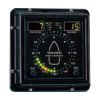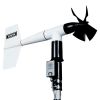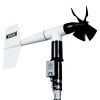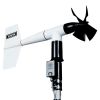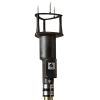YOUNG Wind Trackers
Features
- Wind speed is displayed in your choice of units: KNOTS, MPH, KM/H, M/S
- Wind direction information is clearly displayed on a circular compass pattern of LEDs
- A variety of inputs and outputs including 4-20 mA, Serial (RS-485) & Voltage are standard
- Free ground shipping
- Expedited repair and warranty service
- Lifetime technical support
- More
Overview
The RM Young 06201 Wind Tracker wind speed and direction indicator offers big performance in a compact display. Wind speed is displayed in your choice of units KNOTS, MPH, KM/H, M/S. Maximum wind speed is saved on the display until reset by the operator. A variety of inputs and outputs, including 4-20mA, Serial (RS-485), and Voltage, are standard on the Wind Tracker. Alarms for both wind speed and wind direction are standard.
Design
Wind direction information is clearly displayed on a circular compass pattern of LEDs. Multicolored segments give a quick visual indication of current direction and direction variability. Front panel brightness control allows adjustment for best viewing in any light.
The Young Wind Tracker is very compact. Face size is 144 mm x 144 mm to fit standard DIN panel configurations. Depth is 36 mm for easy mounting on vertical bulkheads or wall surfaces. 12-30 VDC power enables the Wind Tracker to be powered by external batteries or AC wall adapter (included).
In The News
NASA develops ocean surface wind speed measurements through GPS
Researchers from the NASA Langley Research Center in Hampton, Va., have discovered that GPS signals can be used to accurately measure wind speed at the ocean’s surface, National Geographic has reported. Researchers have concluded that by measuring the distortion in GPS signals bouncing off the ocean’s waves, they can successfully measure wind speed, even in the case of hurricanes and extreme weather. To measure the accuracy of using GPS for wind measurements, NASA scientists placed GPS receivers on NOAA research planes. They concluded that GPS data has an accuracy capable of detecting wind speeds within 11 miles per hour.
Read MoreUNC's industry-standard water quality profiling platforms get upgrade
The University of North Carolina Institute Of Marine Sciences has a history with profiling platforms. UNC engineers and scientists have been building the research floaters for 10 years in a lab run by in Rick Luettich, director of the institute. UNC scientists and engineers developed their own autonomous vertical profilers to take water quality readings throughout the water column. They have three profilers placed in the New and Neuse rivers. The profilers are designed to drop a payload of sensors to an allotted depth at set time intervals. Instruments attached take readings continuously on the way down and up. Data collected by the profilers has been used to study water related issues such as infectious disease and sediment suspension.
Read MoreUSGS weather station network monitors Arctic Alaska's climate
When the U.S. Geological Survey began building their climate and permafrost monitoring network in Arctic Alaska in 1998, there wasn't much precedent for how to build the infrastructure for the instruments in the region's unforgiving environment. That meant the scientists had to learn the particulars on the fly. For example: On the great expanse of flat, barren tundra, a weather station sticks out like a sore thumb to a curious grizzly bear. "The initial stations were pretty fragile," said Frank Urban, a geologist with the USGS Geosciences and Environmental Change Science Center. "So the bear and those stations--the bear won every single time without any problem.
Read More








